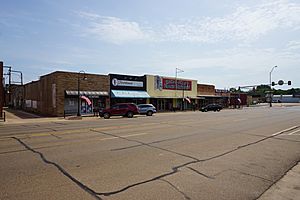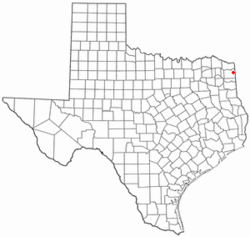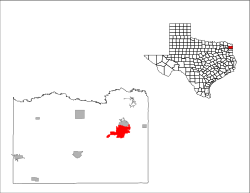Atlanta, Texas facts for kids
Quick facts for kids
Atlanta, Texas
|
|
|---|---|

E Main Street in Atlanta
|
|
| Motto(s):
One City Under God
|
|

Location of Atlanta, Texas
|
|
 |
|
| Country | United States |
| State | Texas |
| County | Cass |
| Government | |
| • Type | Strong City Manager form of Government, Home Rule Charter |
| Area | |
| • Total | 12.65 sq mi (32.77 km2) |
| • Land | 12.50 sq mi (32.37 km2) |
| • Water | 0.15 sq mi (0.39 km2) |
| Elevation | 256 ft (78 m) |
| Population
(2020)
|
|
| • Total | 5,433 |
| • Density | 429.49/sq mi (165.79/km2) |
| Time zone | UTC-6 (Central (CST)) |
| • Summer (DST) | UTC-5 (CDT) |
| ZIP code |
75551
|
| Area code(s) | 430, 903 |
| FIPS code | 48-04516 |
| GNIS feature ID | 2409749 |
Atlanta is a city in Cass County, northeastern Texas, United States. According to the 2010 U.S. census, the city had a population of 5,675, which decreased to 5,433 as of 2020.
History
Atlanta was established in 1872 with the building of the Texas and Pacific Railway and was named for Atlanta, Georgia, former home of many early settlers; a post office was opened that same year. Atlanta, Texas is now the second largest Atlanta in the nation. Other "Atlantas" exist in Arkansas, Louisiana, Missouri, and elsewhere. Atlanta, Texas is known as "Hometown, USA".
By 1885 the community had 1,500 residents, who had founded three white and two black churches, two schools, a bank, several sawmills, a number of general stores, and a weekly newspaper, the Citizens' Journal. Lumbering was the chief industry. The lumber boom reached its peak around 1890, when the population was 1,764. When the community was incorporated in 1929, it had 1,900 residents and 105 businesses.
The onset of the Great Depression in the 1930s forced many businesses to close, and in 1936 Atlanta had 85 rated businesses. The opening of the Rodessa oilfield in 1935, however, helped mitigate the worst effects of the Depression. By 1940 the town had modern canneries, lumber mills, wholesale houses, a brick plant, a hospital, and a population of 2,453. Subsequently, Atlanta grew steadily, topping the 4,000 mark for the first time in the early 1960s. In 1990 the population was 6,118. By 2000 the population had dropped to 5,745. Principal industries include farming, forestry, oil, and tourism.
Geography
Atlanta is the largest city in Cass County and is located in eastern Cass County. It is bordered to the north by Queen City.
U.S. Route 59 bypasses the city to the west, leading north 25 miles (40 km) to Texarkana and southwest 14 miles (23 km) to Linden. Texas State Highway 77 passes through the southern side of the city, leading southeast 10 miles (16 km) to the Louisiana border and northwest 13 miles (21 km) to Douglassville. Texas State Highway 43 passes through the center of Atlanta and leads south 47 miles (76 km) to Marshall.
According to the United States Census Bureau, Atlanta has a total area of 12.7 square miles (32.8 km2), of which 12.5 square miles (32.4 km2) is land and 0.2 square miles (0.4 km2), or 1.19%, is water.
Climate
The climate in this area is characterized by hot, humid summers and generally mild to cool winters. According to the Köppen Climate Classification system, Atlanta has a humid subtropical climate, abbreviated "Cfa" on climate maps.
| Climate data for Atlanta, Texas (1991–2020 normals, extremes 1874–present) | |||||||||||||
|---|---|---|---|---|---|---|---|---|---|---|---|---|---|
| Month | Jan | Feb | Mar | Apr | May | Jun | Jul | Aug | Sep | Oct | Nov | Dec | Year |
| Record high °F (°C) | 85 (29) |
89 (32) |
92 (33) |
96 (36) |
102 (39) |
105 (41) |
108 (42) |
110 (43) |
109 (43) |
99 (37) |
88 (31) |
84 (29) |
110 (43) |
| Mean maximum °F (°C) | 76.4 (24.7) |
79.1 (26.2) |
84.6 (29.2) |
87.5 (30.8) |
92.4 (33.6) |
96.3 (35.7) |
100.2 (37.9) |
101.4 (38.6) |
98.0 (36.7) |
91.3 (32.9) |
82.8 (28.2) |
77.4 (25.2) |
102.6 (39.2) |
| Mean daily maximum °F (°C) | 56.2 (13.4) |
60.1 (15.6) |
68.7 (20.4) |
76.1 (24.5) |
83.2 (28.4) |
90.6 (32.6) |
94.4 (34.7) |
94.7 (34.8) |
88.4 (31.3) |
78.0 (25.6) |
66.2 (19.0) |
58.3 (14.6) |
76.2 (24.6) |
| Daily mean °F (°C) | 44.6 (7.0) |
48.3 (9.1) |
56.0 (13.3) |
63.4 (17.4) |
71.8 (22.1) |
79.6 (26.4) |
83.1 (28.4) |
82.9 (28.3) |
76.2 (24.6) |
65.0 (18.3) |
54.2 (12.3) |
47.0 (8.3) |
64.3 (18.0) |
| Mean daily minimum °F (°C) | 33.1 (0.6) |
36.5 (2.5) |
43.4 (6.3) |
50.6 (10.3) |
60.4 (15.8) |
68.6 (20.3) |
71.7 (22.1) |
71.0 (21.7) |
64.0 (17.8) |
52.0 (11.1) |
42.2 (5.7) |
35.7 (2.1) |
52.4 (11.4) |
| Mean minimum °F (°C) | 21.2 (−6.0) |
26.3 (−3.2) |
30.4 (−0.9) |
38.3 (3.5) |
49.6 (9.8) |
62.3 (16.8) |
68.0 (20.0) |
65.9 (18.8) |
54.3 (12.4) |
39.0 (3.9) |
28.8 (−1.8) |
24.3 (−4.3) |
19.5 (−6.9) |
| Record low °F (°C) | −2 (−19) |
−5 (−21) |
15 (−9) |
31 (−1) |
39 (4) |
52 (11) |
58 (14) |
53 (12) |
42 (6) |
28 (−2) |
16 (−9) |
5 (−15) |
−5 (−21) |
| Average precipitation inches (mm) | 4.12 (105) |
4.67 (119) |
4.51 (115) |
4.46 (113) |
5.17 (131) |
3.86 (98) |
3.29 (84) |
3.10 (79) |
3.86 (98) |
4.42 (112) |
4.06 (103) |
4.76 (121) |
50.28 (1,278) |
| Average snowfall inches (cm) | 0.2 (0.51) |
0.6 (1.5) |
0.1 (0.25) |
0.0 (0.0) |
0.0 (0.0) |
0.0 (0.0) |
0.0 (0.0) |
0.0 (0.0) |
0.0 (0.0) |
0.0 (0.0) |
0.0 (0.0) |
0.0 (0.0) |
0.9 (2.26) |
| Average precipitation days (≥ 0.01 in) | 7.8 | 8.7 | 9.1 | 8.6 | 7.9 | 7.0 | 6.6 | 6.1 | 5.7 | 6.9 | 7.6 | 8.2 | 90.2 |
| Average snowy days (≥ 0.1 in) | 0.1 | 0.3 | 0.1 | 0.0 | 0.0 | 0.0 | 0.0 | 0.0 | 0.0 | 0.0 | 0.0 | 0.0 | 0.5 |
| Source 1: NOAA | |||||||||||||
| Source 2: National Weather Service | |||||||||||||
Demographics
| Historical population | |||
|---|---|---|---|
| Census | Pop. | %± | |
| 1880 | 396 | — | |
| 1890 | 1,764 | 345.5% | |
| 1900 | 1,301 | −26.2% | |
| 1910 | 1,604 | 23.3% | |
| 1920 | 1,469 | −8.4% | |
| 1930 | 1,685 | 14.7% | |
| 1940 | 2,453 | 45.6% | |
| 1950 | 3,782 | 54.2% | |
| 1960 | 4,076 | 7.8% | |
| 1970 | 5,007 | 22.8% | |
| 1980 | 6,272 | 25.3% | |
| 1990 | 6,118 | −2.5% | |
| 2000 | 5,745 | −6.1% | |
| 2010 | 5,675 | −1.2% | |
| 2020 | 5,433 | −4.3% | |
| U.S. Decennial Census | |||
| Race | Number | Percentage |
|---|---|---|
| White (NH) | 3,277 | 60.32% |
| Black or African American (NH) | 1,602 | 29.49% |
| Native American or Alaska Native (NH) | 17 | 0.31% |
| Asian (NH) | 33 | 0.61% |
| Pacific Islander (NH) | 3 | 0.06% |
| Some Other Race (NH) | 26 | 0.48% |
| Mixed/Multi-Racial (NH) | 187 | 3.44% |
| Hispanic or Latino | 288 | 5.3% |
| Total | 5,433 |
As of the 2020 United States census, there were 5,433 people, 2,118 households, and 1,466 families residing in the city.
As of the census of 2010, there were 5,745 people, 2,254 households, and 1,571 families residing in the city. The population density was 525.4 inhabitants per square mile (202.9/km2). There were 2,556 housing units at an average density of 233.8 per square mile (90.3/km2). The racial makeup of the city was 68.13% White, 29.23% African American, 0.52% Native American, 0.37% Asian, 0.02% Pacific Islander, 0.49% from other races, and 1.25% from two or more races. Hispanic or Latino of any race were 1.72% of the population.
There were 2,254 households, of which 32.9% had children under the age of 18 living with them, 47.0% were married couples living together, 18.6% had a female householder with no husband present, and 30.3% were non-families. 27.7% of all households were made up of individuals, and 14.5% had someone living alone who was 65 years of age or older. The average household size was 2.46 and the average family size was 2.98.
In the city, the population was spread out, with 27.0% under the age of 18, 8.7% from 18 to 24, 24.0% from 25 to 44, 21.4% from 45 to 64, and 19.0% who were 65 years of age or older. The median age was 37 years. For every 100 females, there were 83.7 males. For every 100 females age 18 and over, there were 74.5 males.
The median income for a household in the city was $27,188, and the median income for a family was $32,679. Males had a median income of $29,286 versus $19,715 for females. The per capita income for the city was $14,013. About 19.0% of families and 23.5% of the population were below the poverty line, including 33.4% of those under age 18 and 19.4% of those age 65 or over.
Education
Most of Atlanta is served by the Atlanta Independent School District, which operates Atlanta High School. A portion is instead zoned to Queen City Independent School District, which operates Queen City High School.
Atlanta is also served by Texarkana College (the majority of Cass County, including Atlanta ISD and Queen City ISD, is in the college's service area).
Texas A&M-Texarkana is in the area.
Notable people
- Derrick Blaylock, football player Kansas City Chiefs
- Tony Buzbee notable Texas attorney
- Susanna Clark, artist and country/folk songwriter, was born in Atlanta
- Bessie Coleman (1892–1926), civil aviator
- Ellen DeGeneres, talk show host and comedian
- Phil Epps, former American football player
- Tracy Lawrence, country musician
- Andrea Lee, American kickboxer and mixed martial artist
- Gordon McLendon, pioneer of American commercial broadcasting
- Slim Richey (1938–2015), musician, was born in Atlanta
- Max Sandlin is a former Democratic Congressman
- Joseph Strickland, former Roman Catholic bishop
- Drew Stubbs, baseball player
- Nat Stuckey, American country singer
- Ted Thompson, former general manager of the Green Bay Packers
See also
 In Spanish: Atlanta (Texas) para niños
In Spanish: Atlanta (Texas) para niños

